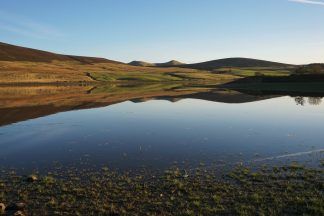Native oysters have returned to the Firth of Forth for the first time in 100 years following a restoration project.
Restoration Forth aims to reintroduce 30,000 oysters to the area and create an oyster reef in the estuary, which in turn will provide a habitat for other species such as fish, crabs, sea snails and sponges.
Oysters also filter the water, improving its clarity. This means more light can reach the seabed, allowing marine plant life such as sea grass to grow through photosynthesis.
Oysters disappeared from the area a century ago due to overfishing and industrial development.
Those reintroduced to the Forth were sourced from Little Loch Broom, near Ullapool in the Highlands, where they were treated to adhere to biosecurity protocols before being transported to their new home.
Caitlin Godfrey, shellfish engagement officer at the Marine Conservation Society, one of the organisations behind the scheme, said: “It’s so exciting that the first native oysters are now in their new home in the Firth of Forth.
“Native oysters have huge cultural value in this area and throughout the project we are reconnecting communities with the fascinating history of oysters in the Forth.
“Alongside seagrass meadows, they will play a crucial role in transforming the future of this coastal environment for both people and nature.
“We couldn’t have got this far with the project without the support of local communities.”
Scottish Government minister Mairi McAllan, whose brief includes the marine environment, said: “I’m honoured and delighted to have been part of Restoration Forth’s historic event, returning native oysters to the Firth of Forth for the first time in around 100 years.
“Communities in Scotland are, as they should be, at the forefront of our nature restoration efforts, and it has been very encouraging to see the drive and enthusiasm of people involved in this project to take action to restore and protect their local marine environment.
“In the midst of a nature and climate crisis, we all have a responsibility to support the recovery of our natural environment.
“The Scottish Government is committed to working with communities to promote nature restoration across the country, and I look forward to seeing many more projects following Restoration Forth’s example.”
Bill Simpson, skipper of the local Conserver boat, said: “I’ve been working on the Forth for over 50 years and have read and heard stories of oysters and Newhaven fishermen.
“It’s good to know we will have oysters back – let’s hope they go forth and multiply.”
Earlier this year, the project successfully planted seagrass seeds in the Firth of Forth, and seagrass shoots have now been spotted, alongside species such as flat fish which have begun using the plants as a nursery.
Partners delivering Restoration Forth include WWF, Edinburgh Shoreline, Fife Coast & Countryside Trust, Heriot Watt University, Marine Conservation Society, Project Seagrass, Royal Botanic Garden Edinburgh, Scottish Seabird Centre, The Ecology Centre and The Heart of Newhaven Community.
Follow STV News on WhatsApp
Scan the QR code on your mobile device for all the latest news from around the country





























